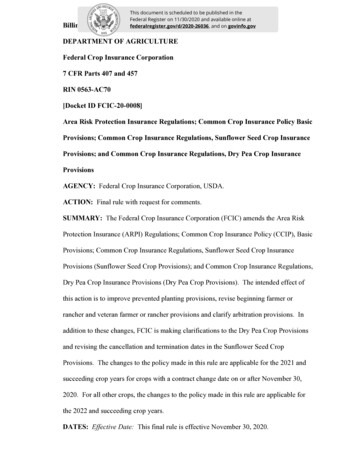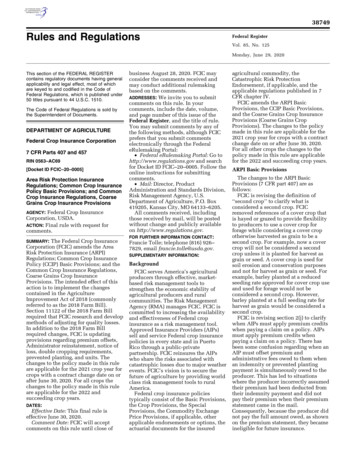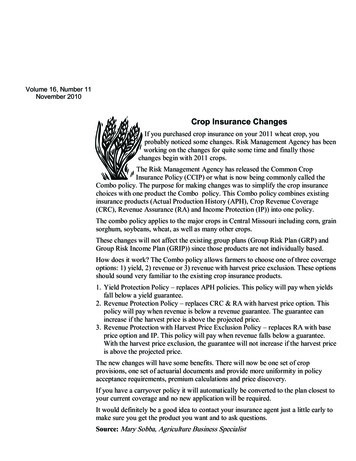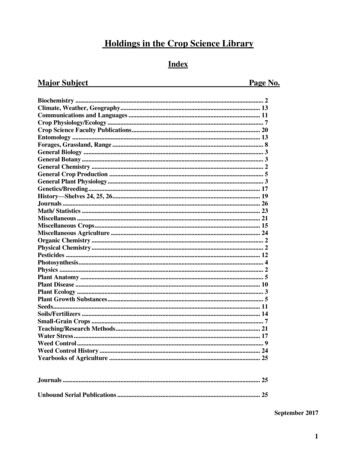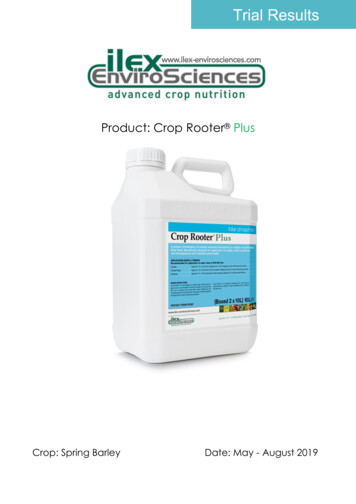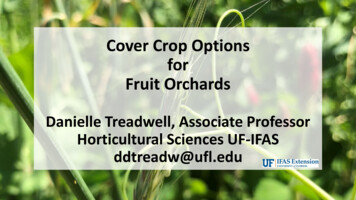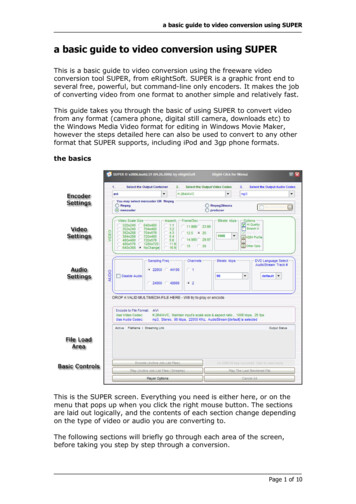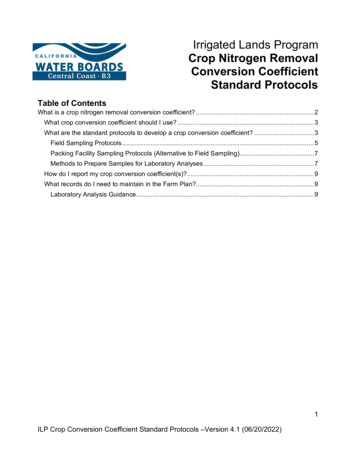
Transcription
Irrigated Lands ProgramCrop Nitrogen RemovalConversion CoefficientStandard ProtocolsTable of ContentsWhat is a crop nitrogen removal conversion coefficient? . 2What crop conversion coefficient should I use? . 3What are the standard protocols to develop a crop conversion coefficient? . 3Field Sampling Protocols. 5Packing Facility Sampling Protocols (Alternative to Field Sampling). 7Methods to Prepare Samples for Laboratory Analyses . 7How do I report my crop conversion coefficient(s)? . 9What records do I need to maintain in the Farm Plan?. 9Laboratory Analysis Guidance . 91ILP Crop Conversion Coefficient Standard Protocols –Version 4.1 (06/20/2022)
What is a crop nitrogen removal conversion coefficient?The Agricultural Order1 includes crop nitrogen removal conversion coefficients (cropconversion coefficient) for crops grown representing 93% of all crop acres in the centralcoast region. University of California Cooperative Extension (UCCE) researchers arecurrently working on developing crop conversion coefficients for additional crops. Thiseffort will increase the crop conversion coefficient coverage to approximately 97% of allcrop acres in the central coast region. This work will be finalized in December 2023.The crop conversion coefficient is the nitrogen content in the fresh weight of the cropmaterial. The crop conversion coefficient multiplied by the weight of the crop materialremoved from the field is used to calculate the nitrogen removed from the field throughharvest or other removal of crop material methods (RHARV 2, 3).RHARV Crop Conversion Coefficient x Crop Material Removed···RHARV is the amount of nitrogen removed from the field through harvest or otherremoval of crop material.Crop Conversion Coefficient is a crop-specific coefficient used to convert fromunits of material removed per acre to units of nitrogen removed per acre.Crop Material Removed is the amount of nitrogen-containing material removedfrom the field, in units of pounds per acre.4 The crop material removed in poundsmust be determined by growers and/or consultants by weighing the fresh harvestedmaterial or employing other methods5 and information generated during harvest.61Agricultural Order No. coast/water issues/programs/ilp/regulatory information.html2Agricultural Order, Page 26, Paragraph r issues/programs/ilp/docs/ag order4/2021/ao4 order.pdf3Agricultural Order, Attachment B – MRP, Page 8-9, Paragraph r issues/programs/ilp/docs/ag order4/2021/ao4 att b.pdf4For crops packed in field and for crops removed as “boxes”, a protocol will need to be implemented foraveraging the weights of the crop material removed in the boxes or packing units.5Growers with crops in pots, trays, and plants produced in any other type of containerized production, suchas nurseries and greenhouses, will need to develop a methodology to consistently estimate the averageweight of plant material removed in units of pounds per acre for reporting purposes. In addition,containerized production systems usually remove soil and/or media (such as peat and perlite growth media)inside pots or trays along with the plants that are harvested. If that is the case, the amount of nitrogenpresent in the soil and/or soil media should be accounted for as a form of nitrogen removed.6To calculate an accurate crop nitrogen conversion coefficient and the amount removed from the fields, theweight (pounds) of the crop material tossed out (culls) at a packing facility needs to be accounted for.2ILP Crop Conversion Coefficient Standard Protocols –Version 4.1 (06/20/2022)
What crop conversion coefficient should I use?Growers must either use a crop conversion coefficient provided by the Central CoastWater Board in the Monitoring and Reporting Program for the Agricultural Order (see TableMRP-47) or develop and use their own crop conversion coefficient. For crops that do notyet have approved crop conversion coefficients, growers must either select a cropconversion coefficient from Table MRP-4 for a crop that is similar to their crop or developtheir own crop conversion coefficient. Growers who elect to develop their own cropconversion coefficient must do so by obtaining a laboratory result from samples collectedfrom their own or similar crop and fields, following the standard protocols described in theremainder of this document. Growers must maintain any data collected and rationale usedin determining their individual crop conversion coefficient in the Farm Plan. Thisinformation must be submitted to the Central Coast Water Board upon request.There are three (3) options to determine what crop conversion coefficient to use:1. Select a crop conversion coefficient provided in Table MRP-4.2. Select a crop conversion coefficient provided in Table MRP-4 for a crop that issimilar to the crop being grown (e.g., similar characteristics, growing stages, andnitrogen uptake amount). For example, the crop conversion coefficient for one type oflettuce may be representative of a different type of lettuce.3. Develop and use your own crop conversion coefficient following the standardprotocols described in this document. Refer to the section in this document titled,“What are the standard protocols to develop a crop conversion coefficient?”What are the standard protocols to develop a crop conversioncoefficient?This section includes the standard protocols that must be followed to develop a cropconversion coefficient. These standard protocols were developed in coordination withUCCE researchers, qualified professionals, and laboratories, and were made available toCalifornia Department of Food and Agriculture (CDFA) for review and comment.There are two values that must be determined to develop a crop conversion coefficient:1. Crop dry matter content (%), and2. Crop nitrogen content (%).7Agricultural Order, Attachment B, Table MRP-4, Page r issues/programs/ilp/docs/ag order4/2021/ao4 att b.pdf3ILP Crop Conversion Coefficient Standard Protocols –Version 4.1 (06/20/2022)
The following formula is used to calculate the crop conversion coefficient:Crop Conversion Coefficient (% dry matter content % nitrogen content) 10,0001. Determine crop dry matter content of the harvested material (% dry matter content)The dry matter content is determined by weighing a sample of the fresh/wetharvested material (to determine “wet weight”) and reweighing it after the samesample is thoroughly dried (to determine “dry weight”). The results can be used tocalculate the percent of dry matter content using the following formula.% dry matter content (dry weight, lab measurement wet weight, field/sitemeasurement) x 100These standard protocols outline two methods to measure the dry weight. For eachmethod the field sampling protocols remain the same and are described below.2. Determine crop nitrogen content of the harvested material (% nitrogen content)The % nitrogen content is analyzed by the laboratory in the dried sample andrepresents the percent of nitrogen content in the dry matter of the harvestedmaterial.Lab results for nitrogen content of the sample are provided on a dry weight basis.This value along with the percent dry matter (calculated by measuring the wet andoven dry weight of the sample) are used to calculate the crop conversion coefficient.Most laboratories will provide both the % dry matter8 and the % nitrogen content indry matter.3. Calculate the crop conversion coefficientExample crop conversion coefficient calculation when laboratory reports both the %dry mater content and the % nitrogen content:Reported % dry matter content 4.7%Reported % nitrogen content 3.5%Crop conversion coefficient (4.7% dry matter content 3.5% nitrogen content) 10,000 0.0016458If the laboratory report includes the % moisture content instead of the % dry matter, the % dry matter canbe calculated as follows: % dry matter 100 – % moisture content.4ILP Crop Conversion Coefficient Standard Protocols –Version 4.1 (06/20/2022)
Field Sampling ProtocolsBefore any samples are collected, follow steps one and two below:1. Select a laboratory from the list provided by the Central Coast Water Board.9 Contactthe laboratory ahead of time to confirm availability and ensure they have establishedprotocols to measure both the % dry matter content and the % nitrogen content of theplant sample in a timely manner.2. Confirm and/or obtain from the laboratory any material necessary to prepare thesamples for shipping, such as plastic or paper bags, markers to label the bags, a neatlyorganized data sheet to record sample information (and fresh weights for Method 2samples), and a sample chain of custody form.Next, follow the procedures below to provide the laboratory with a sample. Thelaboratory only analyzes a small sample of plant material. Therefore, the first step whencollecting a sample is to obtain a manageable quantity (or manageable sample size) ofa representative crop field sample of the harvested crop material. A representative cropfield sample is a small quantity (subset) of material that reflects the same propertiesthat exist in a larger population of the harvested material from a field or crop. To obtaina representative crop field sample to send to the laboratory for analysis, follow theguidelines listed below:3. Collect samples of the crop “at harvest”10, not before or after harvest11, to ensure arepresentative sample of the harvested materials. The nitrogen concentration in theharvested crop is a cumulative value of the amount absorbed during the entire cropgrowing cycle. In situations when the harvest period extends for multiple weeks, anaverage nitrogen crop conversion coefficient will need to be calculated using nitrogencrop conversion coefficients calculated for the harvested material collected at thebeginning, middle, and end of the harvest period. Calculation of an average nitrogencrop conversion coefficient is particularly important in situations where the crop isplanted in blocks with different planting dates and therefore different harvest dates, andfor crops with harvest periods that extend over many months. In all cases, thecompany, laboratory, consultant, or the grower who is taking the samples, mustcomplete and maintain all information related to the sampling event(s), such as a9Includes labs that have a certification or participate in the North American Proficiency Testing, NAPTProgram (coordinated by the Soil Science Society of America) or in the Dr. Robert Miller's AgricultureLaboratory Proficiency program, administered in conjunction with the Collaborative Testing Services, Inc.10Crop is “at harvest” when the grower has decided to harvest and when the harvesting crews are harvestingthe field. In the case of containerized production, samples must be taken prior to the shipping or sales of theplants/product.11The only exception is for crops that must be sampled from the packing facility. See section below oncollecting a sample from the packing facility5ILP Crop Conversion Coefficient Standard Protocols –Version 4.1 (06/20/2022)
sampling map, locations, sampler information, sampling date and protocols, number ofsamples taken, etc.4. Either sample a typical area12 that is representative of the crop field, or sample portionsof the crop material harvested from multiple areas of the field (i.e., from at least 4 ormore locations).13 Combine (i.e., composite) the multiple samples or subsamples into asingle sample for laboratory analysis.5. The sample must include all plant parts that are typically removed from the fields (orshipped, in containerized production). If other crop materials are removed at othertimes of the year (e.g., the removal of pruning’s), they must be sampled separately sothat nitrogen removed in those tissues are also included in the calculated cropconversion coefficient. Collect pruning samples from multiple areas of the field.6. The sample should be free from soil or other contamination that could influence thesample weight or nitrogen content. Shake to remove any soil and/or wipe it off.7. Sample enough plant material so that a representative subsample can be taken fromthe total sample. For example, less material may be needed for a grain crop that hasbeen through a harvester than for a watermelon crop, due to the different harvestmethods and relative size of the individual grains and watermelons.8. Subsampling is commonly required to reduce the size of the sample to a manageablesample size. For example, in the case of lettuce, the entire sample might include 10 ormore heads, which is too much material to send to the laboratory. To properlysubsample a head of lettuce, cut the sample vertically to assure that the samplerepresents all the tissues (older and younger) in the head.14 After cutting the heads, mixthe entire lot of sampled material, and draw slices of the heads at random from themixture until you a have a manageable sample size to submit to the laboratory.9. Once the samples or subsamples are ready, determine the fresh/wet and dry weightsby following one of two methods described below.10. Under any method, if the sample is perishable, and to prevent spoilage and processesthat will alter the original amount of nitrogen removed from the field,12In the case of containerized production, a typical area refers to a bench or outdoor production area (insquare feet). The typical area must be representative of different containers, plant trays, pots, etc.13General guidelines developed to measure the nitrogen (N) content in plant tissue specify a minimum of 20leaves.14In crops where multiple tissues/parts are harvested, each tissue/part needs to be proportionallyrepresented as part of the complete sample. In cases where the parts cannot be mixed and sampledproportionally and/or cannot be analyzed together (perhaps due to differences in texture, such as woody andfleshy plant parts), subdivide the samples, and process disparate parts separately. Afterward, thecontributions of the parts to fresh weight (wet weight) and percent N content can be calculated.6ILP Crop Conversion Coefficient Standard Protocols –Version 4.1 (06/20/2022)
samples/subsamples must be protected from external moisture, internal moisture loss,and contamination until delivered to a qualified laboratory.11. In some instances, such as wheat or seed crops, where the moisture content ismeasured and known at the time of harvest, growers must submit samples to thelaboratory in accordance with either Method 1 or 2 below and provide the moisturecontent.Packing Facility Sampling Protocols (Alternative to Field Sampling)In some instances, samples can be obtained from packing facilities, where harvests arefrequently sampled to determine crop quality, as long as the sample is taken the same daythe fields are harvested. Samples may be obtained at processing facilities if the sample isrepresentative of the crop in the fields, as described in the field sampling protocols above.However, some moisture loss will occur and result in proportional increases in the percentnitrogen in the sample. To minimize moisture loss, samples must be prepared as soon aspossible.Methods to Prepare Samples for Laboratory AnalysesMethod 1: Field fresh/wet and Laboratory dry weight of the samples/subsamples:The fresh/wet weight of the harvested sample is measured at the field site beforewater loss occurs and to ensure an accurate measurement of the fresh moisturecontent of the product.a. Confirm who will be weighing the samples/subsamples in the field to obtain thefresh/wet weight.b. This procedure requires the use of a calibrated scale with accuracy of 0.1grams.c. Record the fresh/wet weight of the sample/subsamples in the field and providethat measurement(s) to the laboratory along with the samples.a. Growers/consultants or individuals weighing the samples/subsamples inthe field must provide the fresh weight value and its corresponding units(grams, pounds, etc.) information for the laboratory to calculate the drymatter content.d. Samples can then be placed into bags (provided by the laboratory) anddelivered (or shipped) to the laboratory. The laboratory will determine the dryweight of the samples (excluding the weight of the bag).7ILP Crop Conversion Coefficient Standard Protocols –Version 4.1 (06/20/2022)
Method 2: Field fresh/wet and dry weight of the samples/subsamples:Follow steps a-c in method 1 above to obtain the fresh/wet weight of the harvestedsample/subsample at the field site before water loss occurs and to ensure anaccurate measurement of the fresh moisture content of the product.This procedure requires the use of a convection drying oven. It also requiresreceptacles to hold plant parts during processing, and tools (e.g., knives, foodprocessors, mills) to prepare the samples for analysis.e. Place samples into bags and bring into the office or field laboratory.f. Upon return to the office or field laboratory, samples are placed in a convectiondrying oven (without the bag) at 60 degrees Celsius ( C; or 140 F) for 48 hours,or until the samples are completely dry. After the initial drying period, samplesshould be removed, weighed, and returned to the ovens for another period ofdrying. No less than 24 additional hours. The samples should be crispy whenthoroughly dried. If still rubbery, they may need an additional 12 to 24 hours ofdrying time. Drying plant material could take several days for some harvestedmaterials, some crops may require grinding of harvested material before drying(e.g., carrots). After the secondary drying period, remove samples from the ovenand re-weigh. Drying is complete if the % change of dry material weight is 5%.Calculate the percent change of dry material weight using the formula below:% change of dry material weight [(initial dry weight – secondary dry weight) initial dry weight] x 100g. The net weight of the oven dried samples (dry weight) needs to be measuredimmediately after taking the samples from the oven to avoid rehydration (the drytissue absorbs moisture from the air quickly). The dry weight is the weightwithout the paper bag.h. The percent dry matter content of the samples will be calculated from thefresh/wet weight and the dry weight of the harvest samples using the followingformula.% dry matter content (dry weight, lab measurement wet weight, field/sitemeasurement) x 100i.Dried samples can then be stored at room temperature in bags (may beprovided by the laboratory) until they are delivered to a laboratory to determinetotal nitrogen content. Inform the laboratory of the amount of time the driedsamples were stored in the bag before delivery to the laboratory, as the nitrogencontent result will be affected by re-hydration and the samples may need to bere-dried at the laboratory to obtain an accurate measurement of the nitrogencontent.8ILP Crop Conversion Coefficient Standard Protocols –Version 4.1 (06/20/2022)
How do I report my crop conversion coefficient(s)?The crop conversion coefficient(s) are reported as part of your ranch Irrigation and NutrientManagement Plan (INMP) Summary Report. It is anticipated that the INMP SummaryReport form will be available in GeoTracker in late 2022. Additional information and detailswill be provided about the INMP Summary Report in late 2022.What records do I need to maintain in the Farm Plan?Records, methods used, and all pertinent information must be maintained in your FarmPlan. At a minimum the records must include all the results, information, andcommunications from the laboratory who performed the analysis, the chain of custodydocumenting all the samples submitted to the laboratories, a list of all the field samplingprotocols to measure the fresh/wet weight and % dry matter content under methods 1 and2 listed above, crop, location, and timing of the sampling.When requested, all records related to the determination of the crop conversioncoefficients must be submitted to the Central Coast Water Board.Laboratory Analysis Guidance1. The laboratories must provide the % dry matter content and the % nitrogen content inthe dry matter. Laboratories must maintain a chain of custody.2. The recommended methodology to measure the nitrogen content is the standard drycombustion method, or the dry method.15,16 The standard dry combustion method(Dumas) is recommended because it accounts for all the different chemical ormolecular forms of nitrogen and the analysis is quick, only about six minutes.3. If the laboratory must dry sugary products, sugary fruits, oil products, pitted fruits, andother types of tissues, consider the following: Pits must be sampled separately. Forsugary fruits/materials the plant material is typically blended and then freeze dried (theycannot be directly dried, so they are first ground into a pulp using a blender or foodprocessor, and then the pulp is dried). The oily materials can’t be ground directlybecause the oil adheres to the blade; instead, they are course ground, and cellulosepowder (no nitrogen contained) is added at a 1:1 ratio to soak up the oil and then the15Information about the dry method can be found at the University of California Analytical Lab Website. Theother common method is the Total Kjeldahl Nitrogen (TKN) method, but the nitrogen present as nitrite (NO2)and nitrate (NO3) forms need to be added at the end of the process, since only organic and ammonia (NH4)nitrogen are only measured via the TKN method.16Consider using the LECO CN928 analyzer. It is a macro combustion carbon and nitrogen/proteindeterminator that utilizes a pure oxygen environment in a high-temperature horizontal ceramic combustionfurnace designed to handle macro sample mass.9ILP Crop Conversion Coefficient Standard Protocols –Version 4.1 (06/20/2022)
sample can be ground more easily. The cellulose-sample mix is then ground andanalyzed. When cellulose powder is added, it will be necessary to convert the %nitrogen content in the mix back to % nitrogen content in the original material. Whenthe ratio is exactly 1:1, the % nitrogen content as reported by the instrument needs tobe multiplied by two.10ILP Crop Conversion Coefficient Standard Protocols –Version 4.1 (06/20/2022)
Select a crop conversion coefficient provided in Table MRP-4. 2. Select a crop conversion coefficient provided in Table MRP-4 for a crop that is similar to the crop being grown (e.g., similar characteristics, growing stages, and nitrogen uptake amount). For example, the crop conversion coefficient for one type of

